Chapter 6: Intelligent Life in the Universe:
The Supernova Connection
From Pure Energy to Question Marks in 12 Billion Years: The Basic Requirements
In this final chapter we consider the implications of the clear fact that we are present to ask questions about the nature of the Universe. In this manner, the Universe has evolved a mechanism whereby it can become self-aware and we, as well as other intelligent life forms, are the agents of this. As agents, we seek to unravel this evolution through observation and discovery. We manifest these activities through the kinds of questions that we pose. From such observations and questions comes a cosmological framework which helps us to understand the Universe and possibly our own existence. In this way, Cosmology may very well be a study of our own origins and that may partially explain why cultures are strongly driven to develop cosmological models.In the previous chapters we have outlined how cosmological models have evolved with time and have focused on our current Hot Big Bang model. Under that model, the Universe formed from a state that was extremely hot and dense. The physics that existed in this Universe are totally unknown. However, once this Universe began to expand, we can describe most of its evolution in terms of the physics that we do understand, with the caveat that, given the nature of the dark matter and dark energy problem discussed in Chapter 5, there remains a lot that we do not yet know. Nonetheless, within our framework it is possible to identify significant physical events which occurred that lead to the development of life. These events are schematically shown in Figure 6.1.
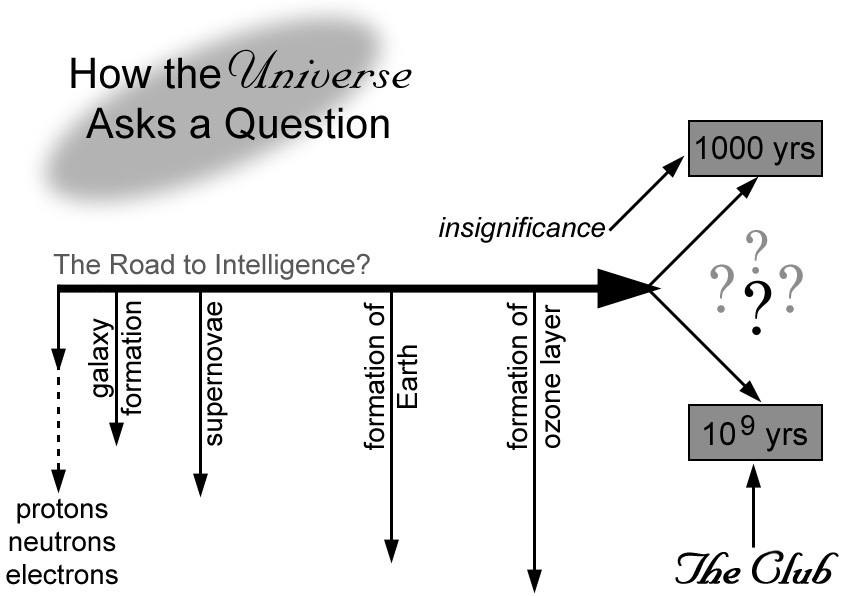
Figure 6.1 Schematic timeline of the growth of intelligence in the Universe and key milestones. See text for explanation.
Figure 6.1 has several important aspects to it. It is simultaneously a look back at the past and a projection into the future. Which future path the intelligent life on the Earth takes may very well depend on how well it understands the past. While it's difficult to define what intelligent life is (any definition that we come up with would most certainly include us), we can objectively view intelligent life as a complex set of atoms and molecules that requires a host planet on which to evolve. As the Universe started from a state of pure-energy, there are several processes that must occur to set the stage for the development of life.
Although the details of this process are complex (and many are unknown), one thing seems clear: the formation of questions (i.e. intelligent agents) in the Universe takes a very long time. This is depicted in Figure 6.1 as the 12 billion year timescale (the approximate expansion age of the Universe). The important milestone along this timeline are:
Formation of Elementary Particles:
Before simple and complex atoms can form, there must first be the formation of elementary particles. As discussed in Chapter 3, elementary particles can form directly from the radiation field via the phenomenon known as pair production. Pair production is the physical manifestation of E = mc2 which allows matter and energy to change forms. This can only occur under conditions of extreme temperature and density.However, if the amount of matter and anti-matter pairs that form from pair production is exactly the same then those matter anti-matter pairs must eventually annihilate leaving a Universe that has only radiation (photons) in it. Thus, the first prerequisite for the formation of life is that there must be an excess of matter over anti-matter. While we do not understand the origin of this matter/anti-matter asymmetry, its existence is extremely important. In our Universe, the excess of matter over anti-matter is about 0.5--1 part in 1 billion. This tiny residue of matter produced everything we observe today, including the observers.
Galaxy Formation - An Element Production Factory:
In order for the elementary particles that compose this matter residue to interact with each other to form individual elements, they must be organized into some system. While the early Universe did create helium due to the fusion of hydrogen, more complex elements beyond helium were unable to form as the Universe cooled too fast for the formation of carbon from helium fusion. Nevertheless, the formation of helium was extremely important as that prevented the decay of the neutrons.We know from stellar evolution that light elements fuse to form heavier ones inside of stars. This thermonuclear fusion process is the way that stars derive their energy and again is a consequence of E = mc2. However, before this process can even begin, stars must form. As star formation proceeds from the gravitational collapse of Giant Molecular Clouds, it is necessary for a gravitational potential well to form in order to collect gas that is destined to fragment into stars. Thus, galaxies serve as gigantic collection places where gas is held together by the large mass which defines the galaxy (most of this mass could be dark matter ). Hence, although the details of galaxy formation remain largely unknown, it's clear that if no galaxies would have formed, there would have been no places in the Universe for gas to collect to form stars and hence the heavy elements that compose planets and people. In this case the Universe would consist only of an expanding sea of hydrogen and helium mixed in amongst all the photons. Moreover, this process may in fact depend on the existence of dark matter as without dark matter, galaxy formation might not have occurred.
Supernova and the Periodic Table of Elements:
The kinds of elements which can be formed in stars depends upon their mass. Low mass stars like the Sun will never generate high enough core temperatures to fuse anything heavier than carbon (due to insufficient mass - lower mass stars require lower core temperatures to maintain hydrostatic equilibrium ). Thus element production stops at carbon (plus some nitrogen, oxygen and neon) in these stars. However, stars with main sequence masses greater than about 10 solar masses can fuse elements all the way up to iron.Through a complicated process, these massive stars become Supernova. During the actual supernova process, the elements in the star's envelope (which is in the process of being violently ejected) is subject to a flood of neutrons and helium nuclei. These particles are captured from the iron seed nuclei that are present to build up the periodic table. There are two basic mechanisms of neutron capture. These are called the slow and rapid process. During the slow, or S-process, neutron capture proceeds at a sufficiently slow rate that when an element reaches an unstable isotope (adding neutrons to a heavy atomic nucleus creates an isotope) it is allowed to decay into a more stable form before it captures another neutron. Note that when a neutron decays into a proton, the atomic nucleus gains a proton and hence becomes a new element. During the rapid, or R-process, the neutron capture rate is so high, that intermediate decays generally can not occur. We can illustrate the difference between the S-process and R-process by considering how cobalt can be formed from an iron nucleus seed. This is shown in Figure 6.2.
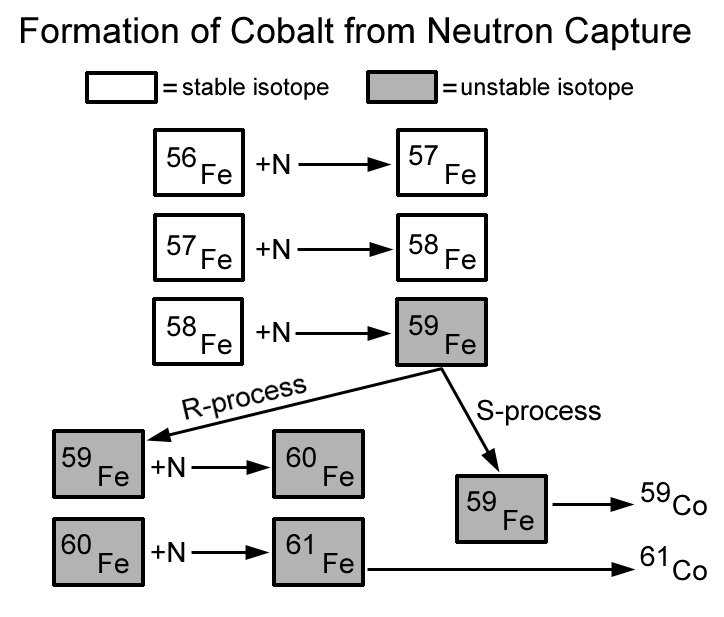
Figure 6.2 Schematic representation of the R and S process pathways for the transformation of iron to cobalt via neutron capture.
The right hand side illustrates the slow process. In this process the original 56Iron nucleus (which contains 28 protons and 28 neutrons) captures three extra neutrons until 59Iron (28 protons and 31 neutrons) is formed. 59Iron is unstable and before it can capture another neutron, one of the extra neutrons decays into a proton, leaving an element with 29 protons and 30 neutrons. This element is 59Cobalt.
The left hand side illustrates the rapid process. In this case, 59Iron captures another neutron before it can decay and then another one to reach 61Iron (28 protons and 33 neutrons). 61Iron, however, is extremely unstable and quickly decays into 61Cobalt (29 protons and 32 neutrons). In this way, the R-process produces neutron-rich heavy nuclei compared to the S-process . Most of the cobalt on the earth is 59Cobalt, indicating a preponderance of S-process heavy nuclei. However, we know that some R-process material is present and it's been quite important for the evolution of the Earth. In particular, Uranium comes in two forms: 235U and 238U. 235U forms from the S-process and is the principal fuel used in nuclear fission reactors. 238U, however, forms from the R-process . Its abundance on Earth is important as it has a half-life of 4.5 billion years and provides the bulk of the radiogenic heat that is the driving mechanism behind plate tectonics.
Through the mechanism of Supernova, the Periodic Table of Elements is created. The most miraculous feature of these Supernova is that they represent very local sites of heavy element formation in a galaxy, but when they explode they hurl this heavy element enriched debris out to radii several hundred light years from the point of origin. Thus, Supernova disperse the elements out of which rocky planets form throughout the galaxy. Indeed, it is not an accident that the age of the Solar System is only about one-half the age of the Galaxy as many generations of Supernova must occur in order for there to be sufficient heavy elements in the Interstellar Medium that facilitate the formation of rocky planets. Since this seeding mechanism occurs on a galaxy-wide basis, there is every expectation of many rocky planets in orbit about the stars. The probability of life forming on those distant worlds is discussed later in this Chapter.
The Formation of the Earth:
After sufficient time had elapsed in the Galaxy, the Interstellar Medium had sufficient heavy elements in it to increase the probability of rocky planet formation. Such was clearly the case for our Solar System in which the inner planets formed from the accretion of small grains, whose origin was from stellar evolution. This accretion process for planetary formation is shown in Figure 6.3.
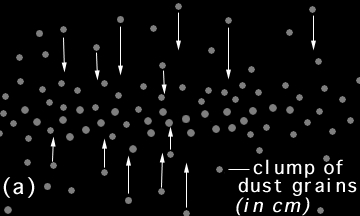
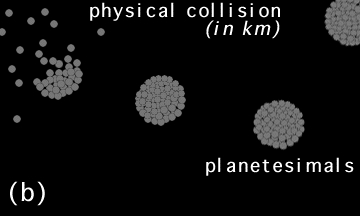
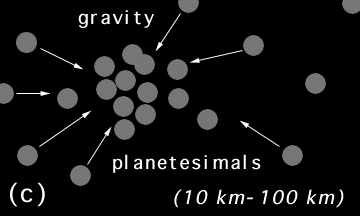
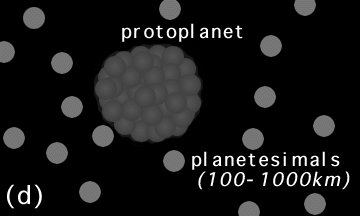
| Figure 6.3 Schematic representation of the accretion process that formed the planets. The rocky material in the inner part of the solar system formed Mercury, Venus, Earth and Mars in this manner. |
Eventually particles, called planetesimals , of radius a few kilometers would form. These objects were sufficiently big that they could gravitationally attract other particles and thus accelerate the accretion process. After a few tens of millions of years, individual planetesimals would merge to form one object, a large protoplanet. Much debris, however, was left over, and that lead to an extensive epoch of cratering in the early history of the Solar System. The heat associated with the accretion process caused the early proto-earth to be in a molten form. This lead to the separation of light and heavy elements in the Earth's gravitational field. Dense molten nickel and iron sunk to the Earth's center while the lighter silicon and aluminum rose to form the crust. The result is a differentiated body with a structure as shown in Figure 6.4. All of the planets in the inner solar system are differentiated bodies as are some of the larger satellites of Jupiter. The particular structure of the Earth (e.g. a very thin crust) will later facilitate the action of plate tectonics which has greatly modified our surface.
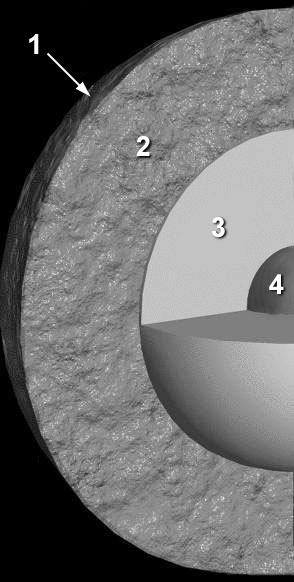
| Figure 6.4 The interior structure of the Earth as defined by 4 components: 1) A thin outer crust 2) a mantle 3) an outer core which is likely molten and 4) an inner core. |
The Necessity of Oceans:
The fossil record of the Earth indicates that the first single-celled creatures, blue-green algae, appear 3.5--3.8 billion years ago. Multi-cellular creatures appeared roughly 1.5-2 billion years ago, and more complex forms started to appear around 600 million years ago. This straightforwardly shows that however life evolved from the simple to the complex, it took hundreds of millions of years. It is quite likely that large bodies of liquid are required to foster such evolution, for two principle reasons:
- Simple organic molecules are easily photo-dissociated
by ultraviolet radiation. Since there was no ozone layer in the
early history of the Earth, the only way to protect these primitive
organic molecules (or amino acids ) would be immersion
in water as water is a strong absorber of UV radiation.
- A liquid medium provides a transport mechanism for these
molecules to move and randomly interact with each other. Quite
possibly, it was millions of years of random interactions and
a trial-and-error process which produced the genetic code DNA
that is the basis for life on this planet.
The Formation of the Ozone Layer:
Throughout most of the history of the Earth, life was confined to the ocean. As photosynthesis increased, more and more oxygen was deposited into the Earth's atmosphere. Ozone is formed via the following reaction:
In order for this reaction to occur both monotomic oxygen (O) and diatomic oxygen (O2) must be present, in the vicinity of another molecule (usually nitrogen) which acts as a catalyst. In general, O is only found at the top of the Earth's atmosphere as it is formed by the UV photo-dissociation of O2. O2, however, is generally found at the bottom of the Earth's atmosphere (as it's produced by surface processes). When sufficient O2 was finally built up, the reaction could occur at a region of the atmosphere where the abundances of the three ingredients necessary to form ozone was optimal. This position is 10-20 km above the surface of the Earth. This region is known as the stratosphere which is the layer above the troposphere where most of the active weather occurs.
Once the ozone layer forms, there is now a significant protective layer which can allow organisms to move from the sea to the land. Shortly after species migrated from the sea to the land, species diversification exploded as there were many new ecological niches to fill. Through tenacity and resilience, evolving life on the land withstood tremendous disasters such as earthquakes, volcanos, major ice ages, occasional asteroid impacts, and slowly intelligence evolved.
A Crossroads: Can we last another 5 billion years?
Our Sun is approximately one-half of its way through its main sequence evolution. However, the growth of humans on the Earth has lead to a substantial non-equilibrium use of the Earth's resources. In just a few thousand years, mankind has gone from a bright, promising future, to one that is severely threatened as our resources run out. This situation leads to the fork in the road that is depicted in Figure 6.1. That fork leads to two possibilities and we should definitely take the road less travelled.Short Term Future: Perhaps humans will not be able to solve the problem of non-equilibrium growth and as a result, will have occupied the Earth as an intelligent species for just a brief period of time. It seems likely that most any civilization would have to endure a primitive phase in their evolution as they struggle to manage their growth and the use of their resources. We maintain this primitive phase primarily as a result of economic considerations. To fuel a global economy, based on trade and production, requires ever greater use of our resources. The current population of the world is 6 billion and the growth is exponential in nature with a rate of 1.8% per year. This leads to a doubling time of 39 years. If our growth remains unchecked, then in 100 years the Earth will have approximately 36 billion humans. While the carrying capacity of the Earth is unknown, it seems unlikely to be this large. Hence, now really is the time that humans find themselves at the crossroads with the choices of short term extinction vs. long term sustainment. As a consequence, we perhaps can pose the following definition of Galactic Intelligence :
Truly intelligent civilizations are those which have established equilibrium with respect to their planetary wide resources
It is the consideration of this definition which leads to the sub-title of Figure 6.1 as The Road to Intelligence with a Test at the End. As we will see in the next section of this Chapter, if other civilizations presently exist in the Galaxy, it is extremely unlikely that they are on the short-term track. Thus, if we wish to be members of the Galactic Club then we must head down the path towards equilibrium.
Long Term Stability: This pathway defines the Galactic Club. The requirement for membership is the ability to survive on your planet on a very long timescale. While our civilization may not qualify for membership we should not uniformly conclude that all civilizations are precluded from membership. What seems to be required for entry into the Club is a different way in which decisions are made. As long as we profit from short term economic based decision making, there will be no incentive to engage in longer term outlook that might help insure the birth of our great-great grandchildren. If we can evolve away from economic based decision making and towards morality based decision making, in which long term sustainability becomes of paramount importance, then perhaps we can achieve this future. The concept is not foreign to us as it comes in the form of the connected world view.
In the very first Chapter we discussed early cosmological models that were centered on concepts such as the Cosmic Womb. Many ancient cultures recognized the interconnectedness of nature and formed a value system centered around the Circle of Life. While this philosophy is not embraced in our material and technical world today, it is important to point out that the idea of interconnectedness has a profound physical manifestation, namely, Supernova.
In principle, our Sun will continue to produce energy at its current rate for approximately 5 billion more years, which means the basic global ecosystem of the Earth can be maintained for this long. On shorter timescales, humans will have large asteroid impacts, large ice ages, and tectonic catastrophe to deal with but the global ecosystem has survived these in the past. We currently stand at the crossroads of choosing whether or not our civilization will even be given the opportunity to confront these challenges. Indeed, if it were to turn out that our civilization was the only intelligent civilization in the entire Universe then if we disappear, that means all the questions in the Universe disappear with us.
The Story of Life on the Earth: All the Details and All the Unknowns:
The story of the evolution of life on the earth, from bio-chemical beginnings to the development of complex creatures is a long and connected process full of potential failure points. Its a story that any modern scientifically literate person should know as it helps to shape our thinking about who we are and how miraculous it is that we are here, as thinking beings, interrogating the Universe. But which is harder for nature to produce, simple life in the first place, or the evolution of life from the simple to the complex? One common view is that so long as a life-supporting environment can persist for billions of years, complex life will inevitable arise. In that case, it is the origin of life that is the hard thing to do.
The Habitable Zone
The one assumption that we make that frames the story is that oceans of liquid water are required for life to inevitbaly arise on a planet. As explained above, the process of planetary formation via acretion sweeps out zones of material. The habitable zone simply refers to a annular region around the host star in which the equilibrium temperature of any planet that might form there is conducive for the preservation of water as a liquid on the surface of that planet. The width of the habitable zone depends upon the temperature/luminosity of the host star. Hottter/brighter stars will have habitable zones that are wider and located farther from the star than cool/dim stars. If a planet accidentally forms, via accretion, in that habitable zone then it is capable of preserving water. As we will discuss later in this chapter, the actual origin of water on the Earth remains a controversial subject. These habitable zone concepts are depicted in the two figures below.
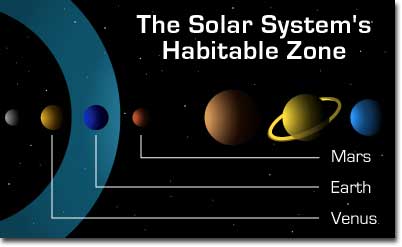
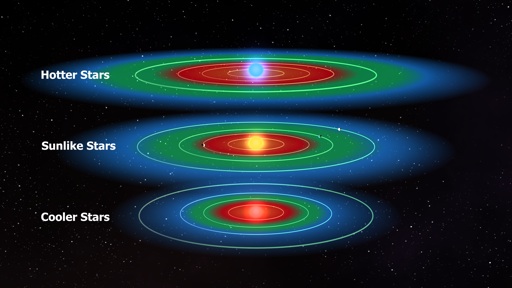
Atmospheric Precursors to life
The forming earth was devoid of an atmosphere as we know have one as well as surface oceans or even surface land masses. It was merely a chunk of molten rock with a Hydrogen and Helium rich atmosphere that quickly escaped. This primary atmosphere was then replaced by a secondary atmosphere due to the outgassing of the Earth in its initial stages. Whether or not this outgassing occured directly thorugh volcanoes or indirectly as simply pressure flows in the Earth's interior is largerly irrelevant. It is a reasonable assumption, however, that the chemical content of that outgassing has been largely unchanged over time. Thus if we measure the effluents from today's volcanoes we can gain insight in to the initial chemical composition of the Earth's secondary atmosphere.
Its is now well established that the three primary gases emitted by volcanoes are:
- water vapor (H20)
- carbon dioxide (CO2)
- sulfur dioxide (SO2
- hydrogen sulfide (H2S)
- methane (CH4)
- ammonia (NH3) - (ammonia emissions are mostly observed from fumeroles and other vents rather than in direct volcanic explosions)
It is well established, via age dating of banded iron formations, whose very existence requires stable surface water, that the oceans formed at least 3.8 billion years ago. There is also some evidence (from detrital zircons - google on that for more information) that the oceans might have existed as early as 4.2 Billion years ago. For our purposes, this means that the oceans formed some 300--700 million years after the atmosphere was in place. In principle this is a long enough time for the atmosphere to have literally rained out is water vapor to fill what are now the oceans. However, it is unclear if there was sufficient water vapor in the atmosphere during these early times to fully account for the current volume of water in the oceans of the Earth - which raises a rather important question - what is the origin of water on the Earth?
The Origin of Water on the Earth
In principle there are two choices:
- All of the water on the Earth can be accounted for by early outgassing.
- Early outgassing was insufficient and some/most/all of our water was externally delivered.
There are basically two external mechanisms available to the Earth:
- Delivery of water by Asteroids
- Delivery of water by Comets
Comet delivery of water is the more natural of these two choices as comets are basically frozen water. However, the temperature in the vicinity of the asteroid belt was sufficiently low that water ice could exist and/or be mixed in with dust grains during the accretion process (The asteroid belt did not form a planet because of the tremendous disruptive gravitational force provided by the relatively nearby, huge mass, Jupiter. If Jupiter had not been so near, another planet, similar to Mars, would have formed in that zone). C-type asteroids (Carbonaceious chondrites) make up about 75% of all the asteroids and have a high water content (10-20% by mass). Impacts on the Earth from these objects would vaporize the asteroid and release water vapor into the atmosphere. So asteroid material does have potential of bringing some water to the Earth.
|
It is also known, from age dating focks on the moon, that over the period 4.1-3.8 billion years ago, there was an epoch of Late Heavy Bombardment which produced the very large lunar maria. Indeed, a very interesting recent discovery from the Spitzer Space Telescope (highlighted in the box to the right) shows evidence that a nearby stellar system is experiencing a large scale cometary bombardment.
The leading theory for the cause of this bombardment in our Solar System involves a gravitational dance between Jupiter, Saturn, Uranus and Neptune that helped rid much of the debris out of which those object formed. This debris would be in the form of cometisimals (1-10-100 km) size chunks of ice. The large mass of Jupiter serves as a point of gravitational focus and hurls these large ice balls into the inner part of the solar system. In principle this mechanism could have brought ALL of the water to the Earth. The implication of this mechanism is sobering. If it Jupiter did not exist in its distance with respect to the Earth and its mass, the Earth might have had insufficient water for life to form. | 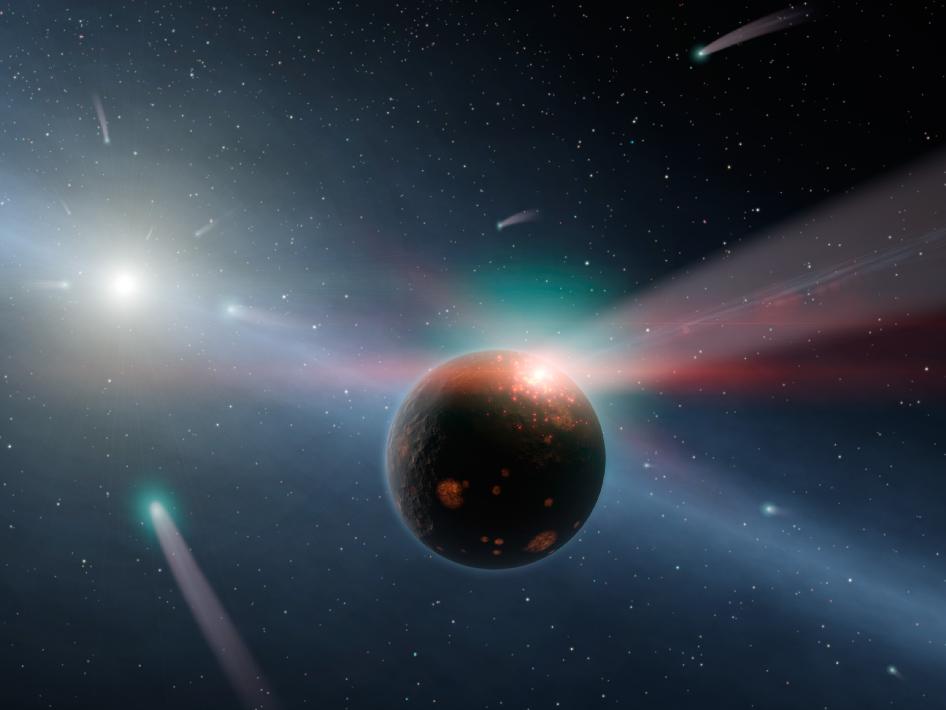
|
Early Evolution of the Earth's Atmosphere
So we are quite sure that by 3.8 billion years ago, oceans of liquid water now exist on the earth and that the surface temperature of the earth is sufficient to prevent those oceans from freezing (this will not always be the case as time moves forward). The formation of the Earth's oceans due to the precipiation of the water vapor from the atmosphere changes the atmosphere in three fundamental ways:
- The density of the atmosphere decreases substantially as almost all of the water vapor (e.g. clouds) is done. This allows a lot more sunlight to reach the surface keeping it warm.
- Most importantly, the rain of water vapor sweeps out almost all of the carbon dioxide as CO2 dissolves in sea water (as it does today). The main chemical end cycle reaction for the removal of CO2 from the atmosphere is the following:
- CO2 + H2O ⇒ H2CO3 (carnbonic acid)
- H2CO3 + Ca++ ⇒ CaCO3 (calcium carbonate a.k.a. limestone)
The end result is that gaseous CO2 ends up being locked into limestone deposits on the ocean floor. The entire process with secondary elements is shown in the image below.
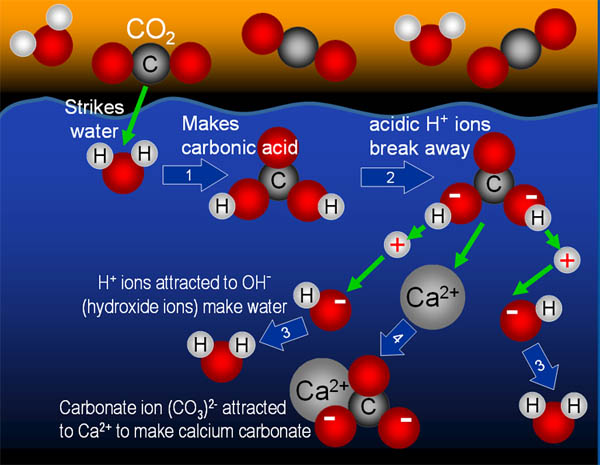
- The sulfur dioxide also reacts with the water precipitate to make sulfurous acid:
- H2O + SO2 ⇒ H2SO3
As a result of this atmospheric cleansing to make the early oceans, we are left with an atmopshere 3.8 billion years ago which is almost completely Nitrogen with traces of water vapor and carbon dioxide. At this time there is NO OXYGEN in the atmosphere as there is no direct mechanism to make it. Biological processes, in particular, photosynthesis need to evolve before oxygen can be produced as a waste product.
Pathways to the Evolution of Life
To illustrate a pathway we constuct 9 necessary steps to get from chemisty in the early atmosphere/ocean to complex creatures that can exist on the land surface. These 9 steps, elaborated on in detail below, can be summarized in this table (BYA = billion years ago):
| Step | Outcome of Step | Timescales/Notes |
|---|---|---|
| 1 | Make Amino Acids and other Monomers | Happens very early and naturally |
| 2 | Concentrate the Monomers to make Polymers | takes a few hundred million years |
| 3 | Invent DNA (by some random process) | single cells emerge 3.5-3.8 BYA |
| 4 | Multiplying Bacteria and the Food Problem | Need to find efficient energy source |
| 5 | Photosynthesis and oxygen release | 500 million years after first bacteria form |
| 6 | Released O2 scavenged by ocean minerals | O2 delayed in getting to atmosphere |
| 7 | Single Cell to MultiCell Organisms | first appeared 1.5--2.1 BYA |
| 8 | Make an Ozone Layer | Formed 600 Million Years Ago |
| 9 | Colonize the Land | Cambrian Species Explosion starting 585 MYA |
In what follows we will detail each of these 9 steps and emphasize failure points that have to be overcome. In this 9 step process, the only physical environments that are important are the atmosphere, the oceans and the land. Evolution within those domains eventually produced life that can exist on the land. However, this 9-step story, may in fact, not be very relevant as the discovery and understanding of deep sea thermal vents has greatly changed our views on how life can arise and its entirely possible that Steps 1 through 4 are driven entirely by deep sea thermal vent biochemsitry.
Step 1: Creating Amino Acids
| The first step in the emergence of life would require simple organic compounds including nucleobases and amino acids, that are the building blocks of life. An experiment in 1953 by Stanley Miller and Harold Urey showed some of these building blocks could be easily formed in a mixture of water, methane and ammonia when this mixture was exposed to an energy source, in this case, as depicted in the figure to the right, an electrical discharge. This mixture was easily found in the Earth's atmosphere and the electrical energy could be provided by lightning discharges. Since the time of the original Miller-Urey experiement, there have been similar experiments that have been done with different mixtures of basic chemical elements that could have been present in the early atmosphere of the Earth. For our purposes, it does not matter what the exact chemisty was, the point is simply that all attemps to synthesize amino acids from basic chemistry have been successful. In addition, meteoritic material (material from objects in the Asteroid Belt) contain amino acids and the NASA Stardust mission, which directly collected samples in comet Wild 2 and returned them to Earth revealed that those samples also contain the basic building blocks of life. Hence it seems that chemical synthesis of amino acids can be done in a wide variety of environments (including the deep sea hydro thermal vent environment discussed later). | 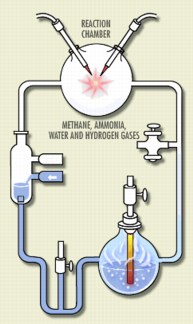 . . |
| In fact, the overall role of comets in the origin of Life story is highly unknown. In addition to their potential role as brings of water to the Earth, there is a theory, not widely accepted in the scientific community, known as Panspermia, which purports that life on the earth was introduced via microorganism and/or chemical precurors brought to Earth via comets. While this is unlikely, it does point out that the Earth is not a closed system and is subject to modification due to external processes (like direct comet or asteroid collisions). The results of the Stardust mission are nevertheless quite important in understanding the origin of the first amino acids. | 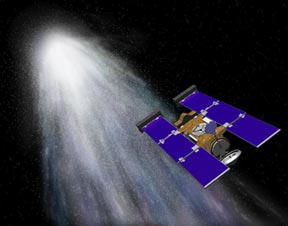
|
| Both the Milley-Urey experiment and the Stardust mission produce/discovered the Amino acid called glycine. In the case of glycine chemical synthesis the reaction is:
The image of this molecule is shown at the right. The large sphere labelled R is just another hydrogen atom but the R stands for the "reactive" side of the molecule. It is this reactive side that is looking to join with aother monomer to make a polymer and that is the next big step that must occur otherwise this process fails and the only thing on Earth are a bunch of monomers dilutely mixed in the oceans. |
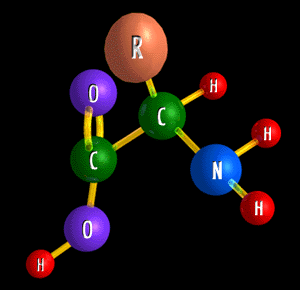 |
Step 2: Concentrating the Monomers
Now we have arrived at our first real failure point. A bunch of monomers loosely mixed into the oceans are never going to intereact at a sufficient rate to stimulate further evolution. Nature must find mechanisms to concentrate the monomers so that they have some chance of combining into a larger moleculue known as a polymer. Long chains of polymers are known as peptides The formation of a polymber from two monomers and the beginning of a peptide is shown in the image below:
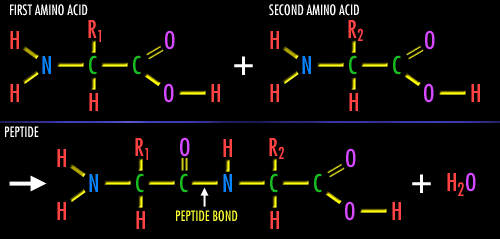
The only practical mechanism for concentration is evaporation that is driven by some agent. Simply put, if you loosely mix something up in solution and pour that into a bucket and then let the water in the bucket evaporate, the solution ends up in a much more dense collection (this is basically how concrete works). So the question of monomer concentration then comes down to the mechanism for evaporation. In this case, there are two clear possibilities:
- heat the surface water
- evaporate the surface water from small concentrations of ocean weater.
However, imagine the case where a relatively large tide has produce an inland tidal pool which might evaporte under the intense sun in a couple of weeks or so. Under those conditions the tidal mud would be come highly concentrated in monomers that were originally in the ocean. The silicate surfaces that compose this mode are known to be good catalysts for polymer formation. This is known as the "Clay Theory" for the origin of life in which this silicate "launch stage" is the crucial ingredient. Since the discover of deep sea thermal chemistry (see below) this theory is begining to wane from popularity within the scientific community.
However, in order for the Clay Theory to even be plausible, there must be an agent that allows for small pools of ocean water to rapidly evaporate. But there is a natural agent. Four billion years ago the moon was substantially closer to the Earth than it is now. Estimates range from 10-20% of its current distance. Since tidal forces scale as distance to the third power (d3 then early tidal forces were 100-1000 times larger than they are today. That means that tides of a few thousand feet high were not that unusual! Those large tides coupled with potentially large storms could have easily formed relatively large inland, shallow lakes, which are prone to rapid evaporation so that the monomers would settle into the clays that formed the lake bottom.
However, experiments starting in 1997 showed that amino acids and peptides could form in the presence of carbon monoxide and hydrogen sulfide with iron sulfide and nickel sulfide as catalysts under conditions of high temperature and pressure, such as those found in a deep sea thermal vent. The successful experiments required temperatures of about 100 C and moderate pressures, although one stage required 250 C and a pressure equivalent to that found under 7 kilometres of rock. These conditions do occur and therefore hydrothermal faciliation of protein synthesis (e.g. polymer formation) could well have occurred in that environment. In fact, this environment is more natural place for this chemistry to occur and perhaps Step 2 is entirely driven by this deep sea process and nothing relevant is happening on the surface. Over time this formed polymers could drift up to the surface. Immersion in a liquid medium is very important for further processes to occur since the liquid medium both protects these large molecules from disruption by ultraviolet light (remember, there is no ozone layer yet) and it serves as a transport and interaction medium.
Step 3: Discovering a Genetic Code
Clearly the achievement of step 2 is not a guarantee that anything more interesting will happen in this biochemical chain. To achieve step 3 something needs to happen in order to organize a system which is capable of self-replication via some genetic code (e.g. DNA). Now the plain truth is that no one understands the details of the process on how DNA was actually formed. The proper question was asked in the a 1994 Scientific American article by Orgel:
- By what series of chemical reactions did this interdependent system of nuclei acids and proteins come into being?
The answer to this essential question is not known (although there are plenty of theories) and since we are just guessing anyway, why not turn to YouTube as an authority:
In our framework, it is now useful to think of the next set of steps in terms of the idea of evolutionary advantage. For instance, its clear that those polymers that can reproduce themselves have a strong evolutionary advantage over those that can't because those that can't die and those that can live. Schematically the process that develops DNA may follow these landmarks:
- Organic polymers in high concentration can separate out from the liquid medium as individual droplets. These may be the first proto-cells
- Long chain moleules (e.g. peptides) can potentially act as a primitive membrane for that proto-cell to control the flow of nutrients/proteins to the proto-cell.
- This exchange process continues, by Trial and Error until the "right" combination is achieved (e.g. DNA).
The fossil record shows that the first primitive cells/bacteria capable of reproduction, known as blue-green algae appear at least 2.8 BYA with some good evidence for formations as old as 3.5 BY. In this sense we know that it took at least one billion years to evolve from atmospheric chemistry to blue green algae via the oceanic pathway. Perhaps then, all you need is time and a reasonable stable environment (like the oceans) to exist for a billion years or so. Give a system a sufficiently long time then highly improbable events or outcomes can occur and 1 billion years is a very long time. Note that once the genetic code is discovered, then certain kinds of polymers can survive (through cell reproduction) then there is no need or stimulus to further search for a perhaps more "efficient" genetic doe since the abilty to reproduce does represent a quantum leap in the ability to survive. As such, DNA might be only local to the Earth and not any kind of "universal" genetic code.
Step 4: Multiplying Populations and the Need for Resources
In this case, while we are talking about bacteria, the parallel with human growth in a finite resource base, is valid. The failure point in step 4 can result if the bacteria are multiplying faster than available energy sources. In this situation, the faster the bacteria are able to find and efficient source of available energy, the more probable it becomes that a particular strain of bacteria well be able to survive.
Now let's imagine the Bacteria planning council and their process of finding food for survival. At the initial council meeting, when the bacteria haven't really figured anything out yet, they simply pass a resolution to eat each other. Some of the wiser bacteria regarded this as a generally bad idea but, at the time, did not have a viable option. And so was developed the process of fermentation, as illustrated below, and the consumption of sugars as an energy source to produce heat, ethanol and lactic acid as waste products. The basic problem here is that fermentation is very inefficient and released very little energy per reaction and therefore is not the energy source that can sustain the multiplying population of bacteria. Thus this first resolution for bacteria survival has failed. They simply can't chemically process each other to provide sufficient energy no matter what kind of chemically pathway exists.
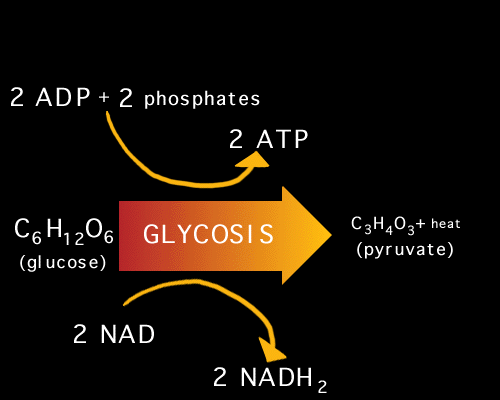
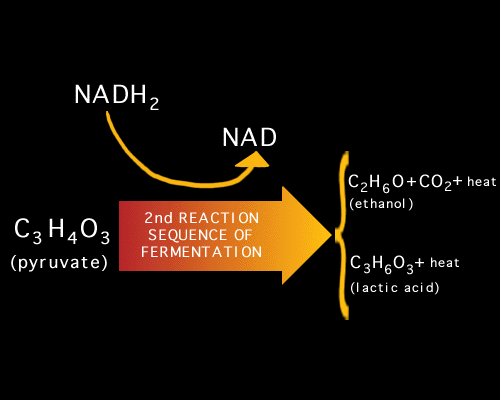
The now newly renamed Bacteria Survial council meets again to propose another resolution. There is much discussion about available resources that can be tapped because the bacteria don't know how to do it. Finally, one bacteria, with a degree in physics notes that the energy content of ultraviolet light is quite high and if the bacteria could just figure out how to use that light to produce useable energy, then they might solve there problem. Right after that, another bacteria with a degree in chemistry notes that the ocean contains a lot of dissolved hydrogen sulfide and carbon doxide molecules, originating both from deep sea thermal vents and diffusion of these gases from sediment deposits and that there ought to be some way to combine these resources with light to do something useful (note: this process is called collaborative problem solving - humans could take a lesson from the bacteria). Early blue grain algae therefore survived because they were the first bacteria to learn how to do anaerobic photosynthesis . In this process light combines with carbon dioxide to help produce cellular materials for the bacteria that use hydrogen sulfide(H2S) as the electron donor in an overall reaction that produces glucose (energy) and sulfur as a waste product (the photosynthesis process ultimately requires the exchange of electrons - between donors and receptors - for it to proceed - the details of this are not relevant to the present discussion). Not very much light energy needs to be captured by bacteria in order to initiate this sequence and so for now, the bacteria do have a viable survival strategy by swimming around in stinky sulphur. However, this doen't help the rest of us.
Step 5: Releasing Oxygen as the Photosynthetic Waste Product
Finally, at the third meeting of the now newly renamed Benevolent Bacteria Society a motion is introduced on how bacteria can be leveraged to help others. Much discussion ensued until the head bacteria said, "You know, we are swimming in essentially an infinite supply of water, why don't we figure out how to do that photosynthesis thing with H2O instead of H2S - afterall, its just switching one letter, call it a typo ..." The basic physics problem associated with switching S to O is that the energy bond between H2O is about 1/3 larger than the energy bond between H2S. Ultimately this means that the bacteria need to more efficiently collect sunlight so that they have more light energy input to begin with. Indeed, this is likely the physical reason that anaerobic photosynthesis in bacteria is developed prior (by a few hundred million years) to oxygen based photosythensis (where H2O is now the electron donor); bacteria need to evolve their physical and chemical characteristics such that they can more efficiently harvest sunlight to perform higher functions. Its important to remember that, at this time before the formation of the ozone layer, these bacteria are able to harvest ultraviolet light and the average energy of an ultraviolet photon is 2-3 times higher than the current average photon received by a bacteria due to the now formed ozone layer effectively blocking all of these UV photons from reaching the ocean's surface.The fossil record indicates that it takes about 500 million years from the appearance of the first blue-green algae engaging in anaerobic photosyntheis to the appearance of bacteria that are able to use water as the reducing agent (the electron donor) thus producing oxygen as a waste product. However, as detailed in the next, rather unfortunate step, this released oxygen does not go immediately into the Earth's atmosphere and this most certainly slows down the evolutionary process that is destined to produce complex oxygen breathing creatures. Indeed, we will have to wait some 2.5 billion years (!) for the oxygen level to build up to its present value.
Step 6: Waiting for the Oxygen
As a consequence of the manner in which the Earth formed through the accretion process there is a lot of dissolved iron in the Earth's oceans. Iron has the ability to chemically capture Oxygen quite easily to settle out as iron oxide (FeO2 banded iron formations are found in many places in the world. For about the first 500 million years of oxygen-based photosynthesis by certain bacteria, none of that oxygen made it to the atmosphere but rather was captured by iron until most of the available dissolve iron settled out to the sea floor. At that point, the free oxygen can make it to the atmosphere and the atmospheric concentration can slowly start to rise.
The so-called Great Oxygenation Event (GOE), was the biologically induced appearance of free oxygen (O2) in Earth's atmosphere. This major environmental change happened around 2.4 billion years ago and the now rising concentration of in the atmosphere produced a fairly poisonous environment for many of the anaerobic bacteria at the time and most of these species of bacteria went extinct in what is likely the largest mass extinction event in the history of the Earth; certainly the largest on the scale of bacteria. It is also possible that the free oxgyen would interact with the Methane content of the atmosphere to accelerate its removal. Methane is also a very important greenhouse gas and sudden changes (either positive or negative) in methane concentrations are known to have cause major climate events in the past.
Importantly, the buildup of oxygen in the atmosphere was relatively slow. This is schematically shown in the image below
where it can be seen that it takes about 1 billion years to reach 20% concentration in the atmosphere. In reality the evolution of oxygen content is not this smooth and involves fluctuations along the way. The major point, however, is that even if nature wanted to make large oxygen breathing mammals, nature would still have to wait a very long time until there was sufficient oxygen to actually breath.
The primary difference between a prokaryote cell and a eukaryote cells is the presence of a DNA containing nucleus in the eukaryotic cell compare to basically a membrane enclosed strand of DNA in the prokaryotic cell. This is visually demonstrated below:
In this form of evolution, the DNA has much higher survival probability when it can be more safely enclosed in a cell nucleus away from any harmful oxygen in the environment.
A competing theory to endosymbosis is known as membrane infolding . Under this theory the prokaryotic membrane itself starts of evolve is shape, structure and thickness. This hypothetical sequence is shown below:
In the physical sense, both of the above theories are compatible with each other as they really on slow structural changes that occur within the membranes. Given that it takes at least 2 billion years for this evolutionary sequence to occur it most not be very efficient or self-evident to the bacteria. Thus, its vey like, as stated before regarding the evolution of DNA is that simple trial and error over billions of years produce an evolutionary pathway such that eukaryotic cells and their associated nucleus do arise in the Earth's oceans. In addition, a eukaryotic cell is compartments/components known as organelles which represent specific locations with certain processes occur. Once in this state, cells have the ability to evolve much more rapidly due to their specialized internal structures that allow for much more efficient energy/nutrient processing. Hence, evolution will now proceed at a much more rapid pace and larger organisms will begin to appear. This rapid cell division is known as mitosis and this is the basic mechanisms that still operates in the cellular world.
Fortunately, the production of the ozone layer as actually a natural occurence in any atmosphere that has oxygen in it. Ozone (O3) is made quite easily via the following sequence:
In this reaction, M, stands for any other available molecule that can act as a catalyst for this reaction.
The nature of this reaction then completely determines the height and thickness of the ozone layer. This layer will form where the concentration of O, O2 , and M reach their mutual maximum values. For the case of our atmosphere, M is basically a Nitrogen (N) molecule (N2)
For the case of the Earth, there is clearly a density gradient so the concentration of M ((N2) is clearly larger at the bottom of the atmosphere than the "top". So why didn't the ozone layer form at the bottom (sea level) of our atmosphere? Well, to form O3 it is necessary to have monotomic oxygen (O) available but the oxygen coming from the oceans is always diatomic oxgyen ( O2). So while the concentratino of both O2 and N2 is highest at the surface,
there is no O found there.
The production of O, actually requires the presence of UV radiation as O is produced through photodissociation of O2:
So, critters are randomly migrating on the land surface by 500 million years ago. We are still a long way from mammals but we have a start. The issue now becomes, survivabilty as mass extinctions and other troubles will now be major obstacles for evolution to overcome. In that sense its unclear what the hard work really is, is it in evolution or is it in survival after you have evolved from a biochemical start to a multiceullar animal.?
In 2003 it was proposed that porous metal sulfide precipitates would assist RNA synthesis at about 100 C and ocean-bottom pressures near hydrothermal vents. RNA is a precursor to the formation of DNA. In particular, a kind of RNA molecule called a ribozyme can catalyze both its own replication and the construction of additional proteins. This has lead to the hypothesis called RNA world in which there were a host of early life forms that were based entirely on RNA and that their self-replication and subsequent interactions eventually led to the formation of DNA. The potential ability for the deep sea thermal vent environment to actively produce RNA adds considerable credibility fro the RNA world hypothesis. Further research on the envioronment of deep sea thermal vents has shown incredible biodiversity and organisms that are able to convert heat (infrared light) into energy via a photosynthetic process.
Thus there may very well be two parallel processes operating on the Earth, both driving the biochemical evolution of light. One in the surface ocean waters and one in the deep sea thermal vent environment which has not changed for the last 4 billion years.
Snowball earth as a Major Failure Point:
In principle, if ocean surface processes are paramount to the evolution of life on the Earth, then this process could be severly curtailed or even elminated if the oceans were to freeze. As the Earth is known to undergo periodic ice ages (mostly driven by long term orbital variations of the Earth about the Sun and the subsequent diminishing of incident solar energy), there is the possibility than the entire surface ocean could freeze. If that were the case, then the surface of the earth now has much higher reflectivity (this is called albedo ) and consequently if left in this condition, the Earth would never warm up to melt all of the surface ice. In that case, it seems prettly clear that the evolutionary process would be stopped.
This condition of total ocean freeze is known as Snowball Earth as depicted in the illustration below:
Due to plate tectonics (see more below) on the millions of years timescale, the distribution of continental land mass area in comparison to ocean surface area changes. The potential severity of an ice age is somewhat dependent upon the latitude distribution of the continental land mass. Snowball earth theory suggests that somewhere between 650 and 750 million years ago most of the continental land mass was piled up near the Southern Hemisphere of the Earth and this lead to a multimillion year period in which the earth was complete covered with ice sheets.
Recovery from this seemingly irrevocable situation occured both as a result of heat flux from the interior of the earth (slow recovery) and an elevated period of vulcanism (rapid recovery) that injected large amounts of carbon dioxide into the atmosphere. Without any surface biomass (since the surface is frozen) to remove the carbon dioxide a substantial greenhouse effect was initiated which caused all the surface ice to rapidly melt.
If the above scenario is correct, then the terrestrial environments are linked directly to the surface ocean environment (since both are frozen and then later melt). New evidence (
Read more about this discovery ) suggests that this linkage allowed for phosphorus based nutrients to more easily flow from the land to the sea and this new, rich nutrient base therefore catalyzed the emergence of more complex life in the surface ocean waters. In this respect, Snowball Earth would therefore actually aid evolution. But, how can the evolutionary process survive the millions of years of being frozen? This question is rather difficult to answer but the resolution may again involve deep sea thermal vents. That environment would be independent of surface ocean water freezing and therefore would sustain the evolutionary process during this crises.
So far, there is no direct evidence to support that Snowball Earth happened or happened more than once. However, there is a lot of evidence that is consistent with this hypothesis and, as discussed we back in chapter 1, consistence is the main requirement for there to be a scientific theory. Hence, Snowball earth remains a viable theory and points to the extreme conditions that evolution must, at times, overcome. The alternative theory to Snowball Earth is known as Slushball Earth . Under this variant, the equatorial waters of the Earth never completely freeze. There are two principle pieces of evidence that favor Slushball Earth:
Whether or not Snowball or Slushball Earth is the correct explanation of this periods of glaciation when life was evolving to more complex forms, is not the central issue of our story. That central issue remains in the form of deep sea thermal vents that, in a very real sense, provide the Earth with a backup mechanism for evolution in case of surface crises. Nature, it would seem, is very clever and very robust and very resilent with respect to the idea of failure.
Mass Extinctions as a Major Failure Point
This supercontinent begin to break apart into individual land masses about 550 million years ago. Evidence suggests, however, that these individual landmasses would then reconfigure themselves into other supercontinents. The last of the known supercontinents is called Pangaea and it formed some 300 million years ago. Its important to note that sea level depends very much on the amount of continental land mass that is present. So between 600 and 300 million years ago, the surface of the Earth was changing in a dynamically complex manner. The current continental drift dates from this last breakup of Pangae which occurred around 200 million years ago. Pangaea and its associated breakup is visualized below:
With respect to species evolution on the land surface, active plate tectonics has two important influences:
However, like large asteroid impacts, global tectonitc activity also has the capacity to cause mass extinctions . The science of mass extinctions is relatively new, having been "born" around 1980 with the pioneering work of Luis Alvarez a geophysicist that first formulated the Giant Impact theory for extinctions. Since the work of Alvarez, many more extinction events have now been found. A mass extinction is generally defined as an event in which at least 1/3 of all species (plant and animal) rapidly become extinct and that this process occurs both on the land and in the sea. The worst extinction event (250 million years ago) was estimated to have extincted 95% (!) of all species. The five major extinction events that have occured over the last 550 million years ago are widely agreed upon and summarized here:
A detailed timeline of extinction events is shown below:
There are several features of the above timeline that are important:
With respect to the story of the evolution of life on the Earth towards intelligence, our new understanding of Mass Extinctions is quite fundamental. This externality clearly reduces the probability that intelligent life will arise on any given planet because there exists the possibility of a terminal extinction event, from which there is no recovery. However, given that Nature has already experienced several near-terminal events andh as recovered then perhaps, Nature, is a lot more robust than we give it credit for. And of course, if the next large impact is tomorrow, then it makes rather little difference as to the nature of our current intelligence since that will be eradicted. But nature, herself, will again, bounce back.
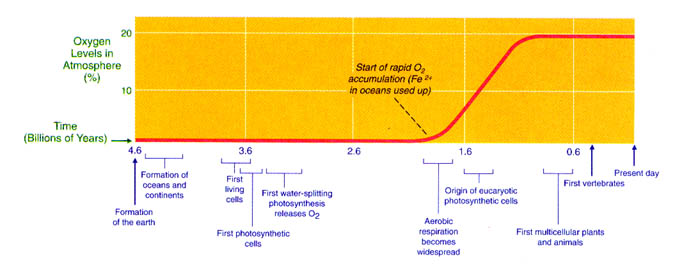
Step 7: From Prokaryotes to Eukaryotes
This step is both the most difficult and the most unknown and therefore represents the most likely failure point in this entire process. Basically, somehow, single cell bacteria ( prokaryotes did evolve to multicelluar creatures ( eukaryotes . But how? No one really knows for sure but there are a couple of leading theories. Before briefly discussing these theories it is again important to remind you of the timescales involved. Single cell bacteria appear 3.5 BYA and multicelluar critters appear 1.5-2.1 BYA. Thus it takes at least 1.5 billion years for this process to happen. Hence, just like the unknown formation process of DNA, perhaps this process also simply requires a long time in a stable environment. Note that one possible stimulus is the presence of Oxygen. Oxygen is poisinous to DNA unless the DNA is contained in a cell nucleus, like it is today, so perhaps the need to protect DNA was the simulus for the evolution of prokaryotic cells to eukaryotic cells.

In order for multicellular creatures to exist, it is necessary that eukaryotic cells exist which strongly implies that somehow the prokaryotic cell structure evolved to a much more complex structure that would allow for the creation of a nucleus. One of the leading theories for this evolution is known as endosymbiosis which suggests that its mutually beneficial to each strain of bacteria. Indeed, strands of DNA encased by only a protective membrane do not have high survival probability. A visual sequence of this evolution is shown below.
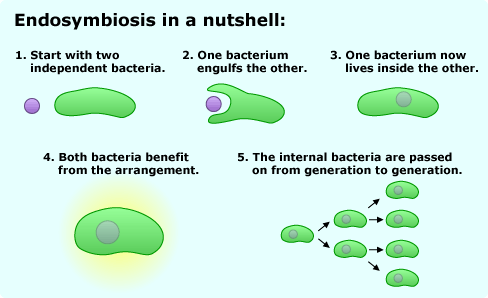
In the July 1 2010 issue of the scientific Journal, Nature, the results of a remarkable discovery of very well preserved fossils found in Gabon were released. There were about 250 fossils that were analyzed and that analysis clearly established proof, for the first time, of the existence of multicellular organisms 2.1 billion years ago. This finding represents a major breakthrough and significantly pushes back the time from 1.5 billion years ago to 2.1 billion years ago for the first appearance of these organisms on the Earth.

Step 8: The Formation of the Ozone Layer
As reproduction by mitosis continues, the rate of creation of large mulicellular organsims increases. However, before step 9 below can occur (creature migration from the sea to the land), the Earth must develop a protective ozone layer in order to shield the land surface from harmful ultraviolet (UV) radiation. UV radiaion can only penetrate a few cm into the ocean water and so the ocean serve as adequate protection for its creatures.
Step 9 Colonizing the Land
It is abundantly clear from the fossil record that prior to 580 million years ago, organisms were very simple but by 530 million years ago there was a major species diversification and the appearance of genuine animals. Fish are the earliest known vertebrates and appear around 530 million years ago Thus, over the course of about 50 million years, evolution accelerated by at least an order of magnitude and this was associated with species adaption to the land surface. While beyond the details of this particular text, it does seem clear that the land surface is a much more difficult environment in which to survive that the oceans (which never really change their ambient conditions) and it is this stress that may very well have been the principle stimulus that drives the diversification of species. Additionaly, at this time in the geological history of the earth there is a very large amount of terrestrial plant life meaning a much more abundant food source awaits on the land than can be found in the sea, at this time.
Snowball Earth and the Necessity of the Deep Sea Thermal Vent?
As stated earlier, the first few steps outlined above may, in fact, not have occurred in the surface waters of the ocean. Instead, similar kinds of reactions may have occurred in the biochemistry of deep sea thermal vents. These deep sea thermal vents were first discovered (by accident) in 1977 and have been the source of intense research since then. While this is currently an area of very active research, sampling is difficult due to location of most of these vents (i.e. under 30,000 feet of water).
 Many organisms are found living near hydrothermal vents, including
tubeworms (see picture, left), mussels, crabs, squat lobsters, limpets,
alvinella worms, scaleworms, zoarcid fish, and octopus. Given the
absence of sunlight, no plants are found here. Instead, microbes
(bacteria and Archaea) form the base of the food chain. These
microscopic organisms are chemosynthetic, using energy from hydrogen
sulfide in the vent fluid, and oxygen and carbon dioxide from the
seawater, to create simple sugars. Some microbes live symbiotically
with organisms such as tubeworms and mussels. Others are free-living
and may be found growing on many different surfaces, including rocks,
tubeworm tubes and other animals, and even inside chimneys.
Many organisms are found living near hydrothermal vents, including
tubeworms (see picture, left), mussels, crabs, squat lobsters, limpets,
alvinella worms, scaleworms, zoarcid fish, and octopus. Given the
absence of sunlight, no plants are found here. Instead, microbes
(bacteria and Archaea) form the base of the food chain. These
microscopic organisms are chemosynthetic, using energy from hydrogen
sulfide in the vent fluid, and oxygen and carbon dioxide from the
seawater, to create simple sugars. Some microbes live symbiotically
with organisms such as tubeworms and mussels. Others are free-living
and may be found growing on many different surfaces, including rocks,
tubeworm tubes and other animals, and even inside chimneys.
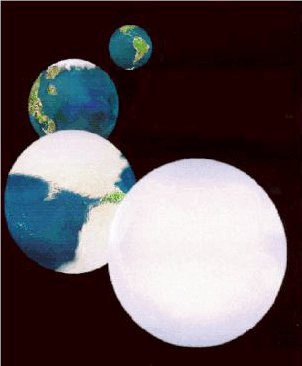
Having survived the periods of intense glaciation, which were likely interrupted by periods of intense vulcanism due to the action of plate tetonics opening up new rifts and pathways to the hot Earth interior, life in some complex form, finds itself on the continental land mass. Geologic evidence suggests that 600 million years ago, the land mass was all connected to one another in the supercontinent called Pannotia:
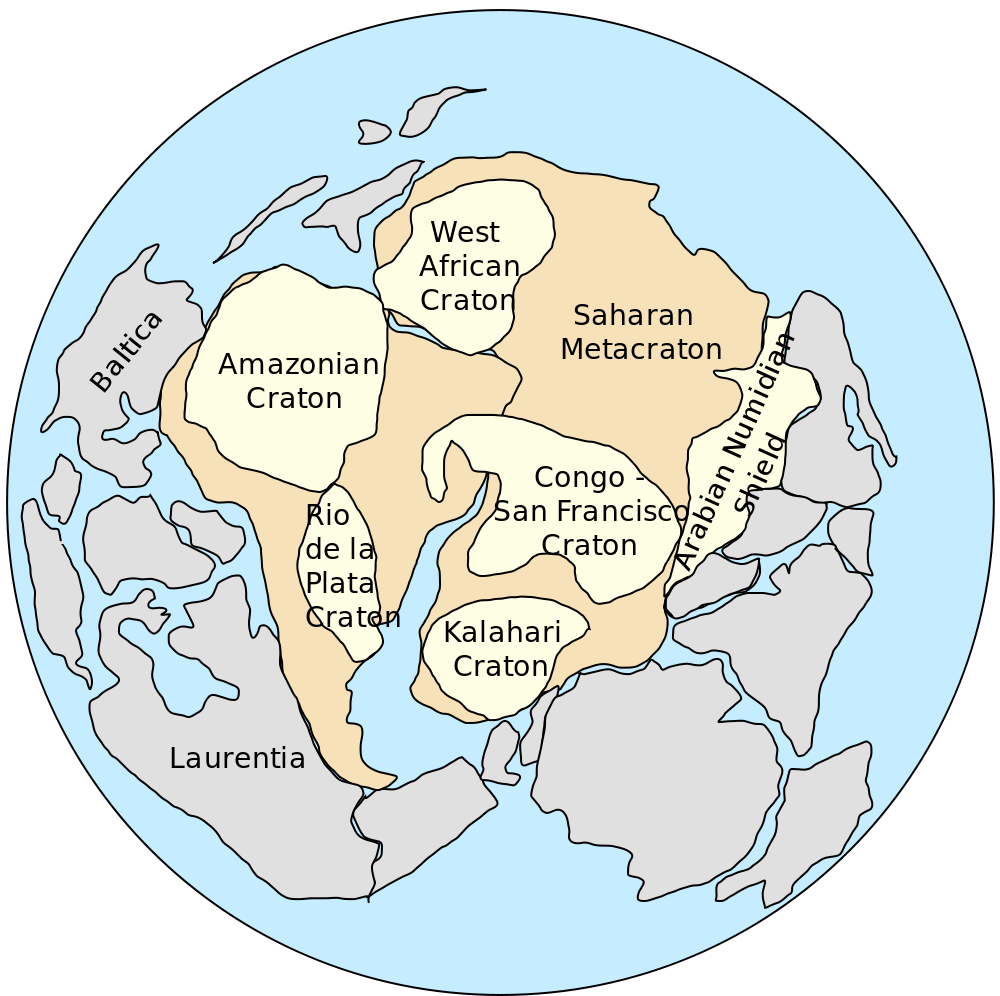
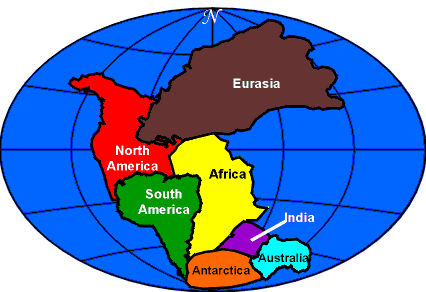
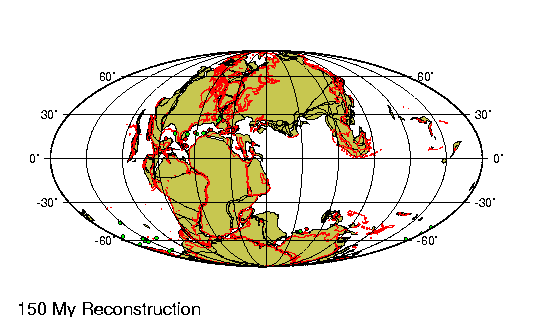
End Thoughts - coming